The elephant in the wind turbine
Jean Van Rensselar, Contributing Editor | TLT Cover Story June 2010
Full-scale efforts are underway to solve the giant gearbox problems that are preventing these machines from reaching their full potential.
KEY CONCEPTS
•
Wind turbines, though not without environmental issues, provide some of the cleanest energy available.
•
The logistics of designing, constructing and maintaining wind turbines are a challenge—the gearbox and its early failure rate is a central issue.
•
There are two possible ways to solve the gearbox problem—either redesign it to reduce the stress on the bearings or eliminate it altogether with technologies such as direct-drive generators.
As enormously powerful engineering marvels, wind turbines produce a significant amount of energy for a relatively small cost and with very little disruption to the environment. Right now, the industry is virtually exploding in growth, enjoying high public acceptance (with some complaints) and full government support. One of the only issues that remains is the massive (40,000-pounds), costly, unpredictable yet critical wind turbine gearbox—which, though designed to operate smoothly for 20 years, is actually falling far short.
Researchers are looking at a number of ways to solve the gearbox problem, most notably by pooling resources with the National Renewable Energy Laboratory’s Gearbox Reliability Collaborative in Golden, Colo.
While the concept of capturing the power of wind and converting it to usable energy has been around since the early Egyptians, the study of efficient wind energy is only about 50 years old, and there are still many engineering puzzles—the gearbox is only one.
In order to understand the complexity of the gearbox issues, it’s important to understand wind turbine logistics.
FROM THE GROUND UP
An estimated 72 terawatt (tw) of the Earth’s wind power is commercially viable. Right now, total global power consumption from all sources is about 15 tw. Depending on design, most wind turbines generate between 0.75 megawatts (mw) and 3.0 mw of electricity. One mw of wind energy is enough to supply electricity to 240-300 homes. There are enough wind turbines operating in the U.S. to power over five million homes.
A typical wind farm consists of anywhere from 10 to hundreds of turbines installed in arrays perpendicular to the prevailing wind direction. The turbines sit on towers up to 300 feet above the ground to take advantage of less turbulent but faster wind with rotor diameters often reaching more than 250 feet.
The turbine tower is anchored in a platform of over 1,000 tons of concrete and steel rebar that’s 30-50 feet across and 6-30 feet deep. The tower alone weighs about 140,000 pounds ton, and the nacelle (which houses the gearbox and is about the size of a school bus) weighs about 110,000 pounds. Just in case the tower doesn’t have enough weight bearing on it already, some nacelles are equipped with a helicopter-landing pad.
Wind turbines consist of a rotor with wing-shaped blades that are attached to a hub. The hub is attached to the nacelle, which houses the gearbox, connecting shafts, support bearings and a generator.
In a typical wind turbine design, the rotor blades attach to a low-speed shaft that extends into the gearbox. In the gearbox, gears connect the low-speed shaft to the high-speed shaft and increase the speed of the blades’ rotation from about 25-60 rpm to 1,000-1,800 rpm—the rotational speed required by most generators to produce electricity. The high-speed shaft turns inside the generator, producing AC electricity.
Modern wind turbines are designed to work most efficiently at wind speeds of about 25 mph. Because the wind is often stronger than this, a wind turbine must adapt itself to the prevailing wind speed to operate most efficiently, by automatically adjusting the blade speed or blade angle with a computer-controlled yaw system that turns the turbine and aligns the blades for maximum efficiency.
The size of the rotor or “swept area” ultimately determines how much energy a turbine can harvest from the wind. The electricity must be produced at a frequency and voltage that’s compatible with the utility grid. Not all wind energy is available for energy conversion. According to Bert’s Law, no turbine can capture more than 59.3% of the kinetic energy in wind (
1).
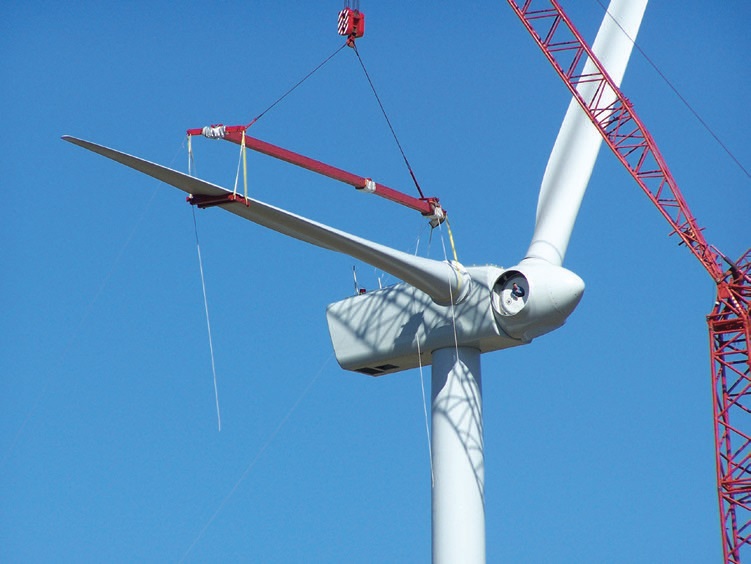 Wind turbine blade installation. Each approximate 115-foot blade sweeps an area of vertical airspace that is about the size of a Boeing 747. (Courtesy of Barnhart Crane & Rigging).
THE ENVIRONMENT AND SAFETY
Wind turbine blade installation. Each approximate 115-foot blade sweeps an area of vertical airspace that is about the size of a Boeing 747. (Courtesy of Barnhart Crane & Rigging).
THE ENVIRONMENT AND SAFETY
A 1.5-mw wind turbine (the most common size) will annually displace about 3,000 tons of carbon dioxide generated by nonrenewable energy sources such as coal. From an environmental perspective, the fact that wind turbines don’t create any CO
2 emissions puts them miles ahead of all nonrenewable energy sources. One area of concern is leaking lubricant and hydraulic fluid, especially where wind turbines are operating offshore.
According to Doug Lucas, manager application engineering for Wind Energy, Timken Co., most gearbox lubrication leakage is contained in the head of the turbine (the nacelle). But there may be lubricant leakage in the blade bearings (not very noticeable because manufacturers changed the color of that lubricant to match the color of the blade).
Wind farms are so pollution-free that farmers commonly lease land to wind farm developers and can safely cultivate crops near the turbines (
2). For example, to create the Twin Groves Wind Farm in Ellsworth, Ill., 300 farmers signed agreements with Horizon Wind Energy removing, on average, less than an acre each from crop production to create the 240-turbine farm. The facility provides electricity to about 120,000 homes.
As energy-creating behemoths go, wind turbines are easy on the eyes. In the U.K., surveys show that most people either like or don’t mind the visual impact. In one Scottish hamlet, villagers say the turbines have a calming effect. However, some people are complaining about headaches, nausea and other health issues they say are related to turbine noise and vibration; others say turbines are no louder than refrigerators.
“They do make noise,” explains Sandy Butterfield, CEO of Boulder Wind Power in Boulder, Colo. “But the noise is like wind blowing through trees. In general, the noise volume depends on the design.”
Another aesthetic issue is the flashing lights that top the turbine towers.
Bird-lovers are suspicious of wind turbines, citing the potential for birds to be injured by flying into the blades. The Peñascal Wind Power Project in Kenedy County, Texas, is located in the middle of a major bird migration route and solved the problem by using NASA-developed avian radar technology to detect birds as far as four miles away—if birds are in danger of flying into the blades, the turbines automatically shut down and restart when the birds have passed.
Human safety is another issue. Over the past 10 years, there has been an upward trend in the number of accidents resulting in injury and death involving wind turbines due, at least in part, to the greater number of turbines in operation. The largest number of incidents by far are due to blade failure, which results in either whole blades or pieces of blades coming loose and projecting off the turbine. In Germany blade pieces have penetrated the roofs and walls of nearby buildings. Another frequent cause is fire because burning debris tends to scatter over a wide area. Other causes include falls and being hit by falling structures and ice projectiles. Because of this, most European countries don’t allow occupied buildings within a two-kilometer radius of turbines (
3).
Since gearboxes are installed where the wind is the strongest, up to 300 feet above the ground, maintaining them can be precarious. Unless the tower is equipped with an elevator, maintenance workers often have to climb an internal ladder to the top of the tower. Turbine manufacturers have a set of worker safety guidelines that stress proper training and following procedures.
Maintenance in wind turbines is easier and safer when parts such as filters and ports for draining, filling and sampling are located in an accessible area.
OTHER ISSUES
Critics cite the unpredictability of wind and the impracticality of storing wind energy as two major drawbacks of wind turbines.
According to Butterfield, neither is a real issue. “Wind energy is not as highly variable as people think,” he says. “We can predict how much wind power we will use 24 hours ahead of any hour of the day with weather models that are highly tuned for a specific site. The accuracy of these models is within 15% of the actual value.”
Walter Musial, principal engineer for the National Renewable Energy Laboratory, agrees that, because of grid logistics, storage is not an issue. He explains that wind energy is only one of several power sources (hydroelectric, coal, nuclear, solar, geothermal, etc.) entering a typical electric grid. The grid operator continuously adjusts the sources to meet demand. When wind isn’t available, other sources are.
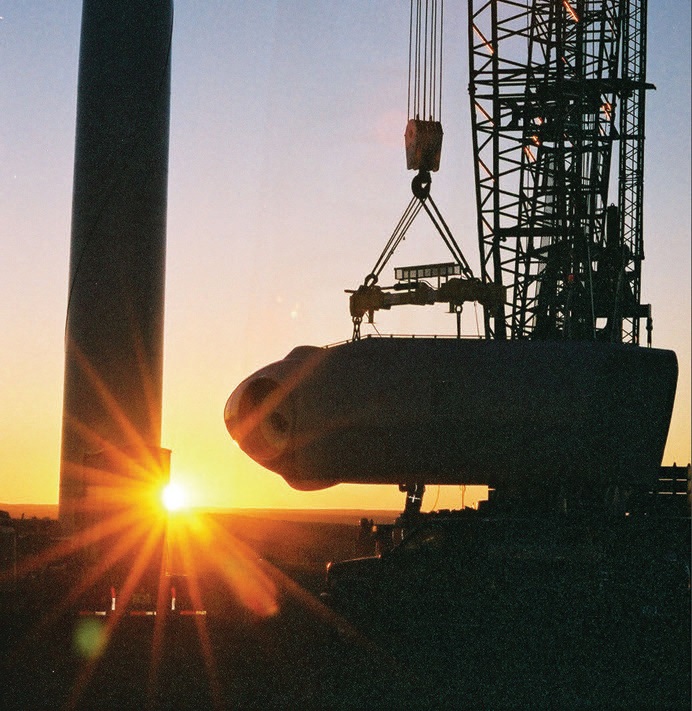 Wind turbine nacelle installation. The nacelle weighs about 110,000 pounds and is the size of a school bus. (Courtesy of Barnhart Crane & Rigging).
Wind turbine nacelle installation. The nacelle weighs about 110,000 pounds and is the size of a school bus. (Courtesy of Barnhart Crane & Rigging).
“You have to look at the grid holistically,” Musial explains. “You account for low wind conditions by increasing the supply of some other generating source. Theoretically, storage would become an issue only when you have high penetrations of wind energy on the grid relative to its entire capacity, but at the current industry level, that doesn’t come into play.”
Wind turbines: Tale of the tape
A 1.5 MW wind turbine has:
•
A total height of about 328 feet.
•
A 212-foot tower.
•
Three 116-foot blades that sweep an area of vertical airspace that is about the size of a Boeing 747.
•
A concrete and steel rebar platform 30-50 feet across and 6-30 feet deep.
•
A total weight of about 328,000 pounds.
•
A nacelle the size of a school bus weighing about 112,000 pounds.
•
An approximate 7-foot-by-7-foot gearbox weighing about 35,000 pounds.
•
A blade assembly weighing about 72,000 pounds.
GHOST IN THE GEARBOX
High gearbox failure has been a problem from the beginning—when design flaws and overly optimistic operating load estimates accounted for most of the problems. Researchers from relevant disciplines worked together to address the issues and establish gearbox standards, but the gearbox failure rate is still high, and the failure rate is expensive.
GEARBOX BASICS
Most industrial gearboxes work by converting high speed and low torque to low torque and high speed, but wind turbine gearboxes work the opposite way by converting low speed and high torque to low torque and high speed. All of this is accomplished with gear and bearing sizes larger than the typical gearbox.
STLE-member Mike Kotzalas, manager of bearing fundamentals and advanced modeling for the Timken Technology Center in Canton, Ohio, explains, “So the difference in the momentum level between most gearboxes and a wind turbine gearbox is the difference between hitting the brakes on a small passenger car and hitting the brakes on a huge truck.”
High loads due to wind gusts and inner turbine vibrations are the norm. Intermediate bearing bodies, such as balls and rollers, vibrate against the outer and inner rings causing the grease to squeeze out of highly loaded contact areas. This generates wear marks and a rippling effect that severely damages bearings.
Especially when winds are light, sometimes the turbine is simultaneously operating under a medium-sized load at low speeds and a low load at high speed. This leads to the breakdown of the lubricating film that’s necessary for long bearing life.
Wind turbine gearboxes have yet to achieve their original design life goals of 20 years. Most turbines require significant repairs and even complete overhauls in the 5-7 year range, well before that benchmark. High repair rates of the expensive gearboxes are one of the major contributors to wind turbine operating cost increases and the escalating cost of wind energy.
Most wind turbine downtime is attributed to gearbox-related issues. Gearbox replacement and lubrication account for 38% of the turbine’s parts cost. Taking into account the cost of the gearbox, crane rental, labor and lost revenue, replacing a gearbox for a 1.5-mw turbine can run more than $250,000.
“There are actually many more failures in the electronic components than in gearboxes, but gearboxes are much more expensive to fix,” Lucas says. “You need to get a crane out there—which, because there aren’t that many cranes in the world that can handle this—can mean several weeks of down time by itself. The difference in down time for an electronic component failure and a gearbox failure is days or hours vs. weeks.”
Musial agrees. “Electronics and gearboxes are both problems,” he says. “But electronics are more nuisance failures.”
CONTAMINANTS
One of the greatest sources of contamination occurs during manufacturing. Standard filters do not necessarily remove built-in manufacturing contaminants. As a result, damage, including permanent debris dents, can occur during run-in. Assembling gearboxes in a clean environment, using careful procedures and filling them with clean lubricant, reduces the risk. Researchers at Imperial College in London proved that rolling element bearing life can be increased seven times simply by changing from a 40-mm filter to a 3-mm filter prior to run-in.
During operation, internally generated contaminants include wear debris particles from micropitted bearings, gears and other components. Micropitting, common in gearboxes, reduces accuracy, creates noise and may lead to other issues such as bending fatigue and macropitting. Inactive wind turbines are subject to fretting corrosion on the gear teeth, bearings and splines.
Wind turbines in desert environments are exposed to airborne dust during the hot season and moisture during the rainy season. Offshore turbines contend with constant moisture. In fact, it’s nearly impossible to keep gearbox-lubricating oil completely separate from water because of the constant (moisture-creating) heating and cooling of the gearbox.
GEARBOX FAILURES
While gear failure used to be a primary cause of wind turbine gearbox problems, the current generation of turbines fails most often from bearing surface fatigue. The debris produced by this failure leads to abrasion of other components of the gearbox.
Critical failure locations include planet bearings, intermediate shaft-locating bearings and high-speed locating bearings. Gear failure can occur independently of bearing failure for reasons such as wear from poor lubrication, abrasion and surface fatigue initiated by bearing debris.
Lucas explains, “The dynamics of the system are a challenge. The loads go from very high to very low quickly—there are vibrations and oscillations within the entire drivetrain system—and the system needs to adjust. There will always be a weak link in every system. The bearings appear to be the problem right now, but I think they are just showing the damage first. There is a lot of demand on the bearings, but it’s really a system issue. The gearbox just happens to be in the middle of the drivetrain.”
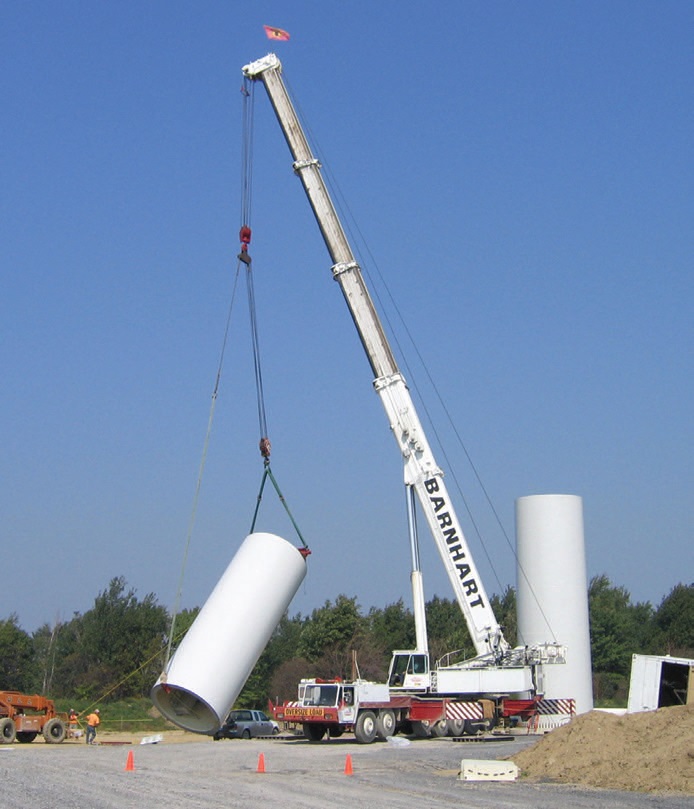 A state-of-the-art rigging system allows a single crane to pickup an angled load that usually requires two cranes. (Courtesy of Barnhart Crane & Rigging).
A state-of-the-art rigging system allows a single crane to pickup an angled load that usually requires two cranes. (Courtesy of Barnhart Crane & Rigging).
Recently, researchers have drawn the following conclusions about the nature of gearbox failures (
4):
•
Most of the problems with the current fleet of wind turbine gearboxes are generic, not specific to a single manufacturer or model.
•
The volume of gearbox failures suggests that poor adherence to accepted gear industry practices or poor workmanship are not primary sources of failures.
•
Most gearbox failures do not begin as gear failures or gear-tooth design deficiencies. Rather, failures tend to stem from several specific bearing locations under certain applications, which, due to debris, may migrate into the gear teeth.
Despite the fact that most gearboxes are designed and developed using the best practices available, the majority of wind turbine gearbox failures appear to initiate in the bearings (
5).
The same problems that manifested in the smaller turbines 5-10 years ago persist in today’s larger turbines.
THE GEARBOX RELIABILITY COLLABORATIVE
One of the main problems in addressing and mitigating gearbox problems is the proprietary nature of gearbox design and manufacture. Each manufacturer uses its own internally developed design codes that can introduce significant bearing differences. There’s a way to solve this.
The National Renewable Energy Laboratory’s (NREL) Gearbox Reliability Collaborative, now in its third year, is a cooperative made up of research professionals and key representatives of the supply chain, such as turbine owners, operators, gearbox manufacturers, bearing manufacturers, lubrication companies and wind turbine manufacturers. Its goal is to give participants a venue for mitigating gearbox issues without compromising intellectual property.
During the first year, Collaborative members designed the project; in the second year, they executed the tests; and this year they are gathering, analyzing and summarizing the data.
There are three aspects to the Collaborative’s program:
Drivetrain Analysis and Modeling: Software analysis tools are modeling the internal gear and bearing load reactions and internal displacements and motion under simulated field conditions.
Full-Scale Dynamometer Testing: The testing is occurring on a 750-kw drivetrain at the NREL’s dynamometer test facility. This will allow accelerated testing of new designs.
Field Testing: Wind farm field tests are being conducted on the same drivetrain used in dynamometer testing.
“We’ve enlisted members from the supply chain of gearboxes that are helping us pinpoint design problems in gearboxes and solve problems in gearbox failure,” says Musial, a Collaborative member and organizer. “We believe that you can’t really solve this problem unless you have the cooperation of everyone in the supply chain.
“We will look at field and lab measurements and look for common anomalies and inconsistencies—things that might be possible causes of bearing and gear failures. There are a lot of things that have to happen in a linear way. The testing we did didn’t generate a failure, but we’re looking for behavior that could cause a failure. We’ve generated a dataset from the field and dynamometer and will be looking at any data that isn’t consistent.”
Butterfield was also a Collaborative organizer and member. According to him, overcoming the privacy issue was a significant achievement.
“For a long time, we’ve all known that there are multiple entities involved with the gearbox reliability issues,” he says. “They all have a different understanding—some piece of that puzzle that, because of confidentiality issues, they couldn’t get together and talk about. We were able to reverse-engineer the gearbox and keep the source of the design private.”
The NREL mitigated intellectual property concerns by using representative wind turbine configurations and parts to run tests without replicating any manufacturer’s wind turbine model. Ultimately, Collaborative members would like to build a large failure database in order to use current failure rates as a baseline for verifying future reliability improvements.
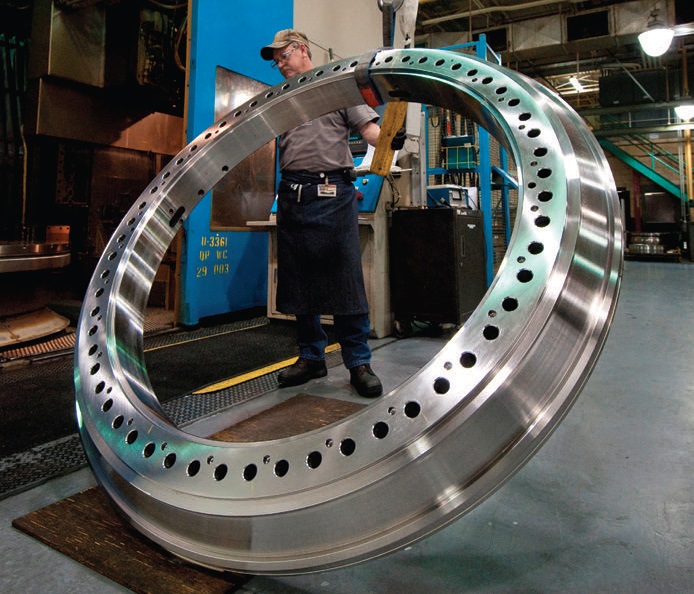 A technician at Timken’s Tyger River, South Carolina facility hoists a main-shaft bearing produced at the facility. (Courtesy of The Timken Co.)
GEARBOX LUBRICATION
A technician at Timken’s Tyger River, South Carolina facility hoists a main-shaft bearing produced at the facility. (Courtesy of The Timken Co.)
GEARBOX LUBRICATION
Wind turbine lubricants must withstand extraordinary demands in terms of temperatures, bearing wear and load weights.
Grease lubricant is used to lubricate blade root bearings, main-shaft bearings and yaw bearings (for grease-lubricated bearings, there is now an automatic grease system used in many of the newer turbines). The gearbox is oil lubricated, and some of the newer, larger turbines are oil force fed with a pump that automatically and periodically drives oil into the gears.
Because the main gearbox is the most challenging turbine part to lubricate, NREL Collaborative tests included automated spray lubrication with the lubrication channeled directly to the bearing races. The American Gear Manufacturers Association and the American Wind Energy Association developed an industrial standard (AGMA/AWEA 6006-A03) that provides guidelines for specifying, selecting, designing, manufacturing, procuring, operating and maintaining gearboxes for use in wind turbines. But the bottom line is that maintenance workers need to follow the manufacturer’s guidelines to remain in warranty.
There is a trend toward synthetic formulations (PAO/ ester, ester and PAG-based). Synthetics are more prevalent in wind turbine gearboxes because they have significant viscosity, hydrolytic and micropitting-resistant advantages over mineral-based oils.
PAOs (polyalphaolefins) have an excellent viscosity index and a low pour point, providing superior lubricity for operating temperatures that can range from -49 F to 176 F.
PAO/Ester Blends are highly stable in the presence of water—important since moisture is an issue with wind turbine gearboxes. PAGs (polyalkalene glycols) resist micropitting better than other lubricants but have compatibility issues with coatings and seal materials. The ideal wind turbine gearbox oil would have the thermal stability of premium hydraulic oil, the extreme pressure properties of current gear oils and additives to prevent micropitting.
Oil drain intervals are typically 8-12 months, with one major manufacturer recently extending the interval to 16 months. New generation offshore wind turbine oils could have drain intervals of up to three years. Newer filters are compact and provide fine filtration without creating large pressure drops.
FUTURE FIXES
Much of what happens in the future depends on the conclusions and recommendations of the Gearbox Reliability Collaborative. However, new technologies and new guidelines are in the works. For example, the International Electrotechnical Commission (IEC) is currently developing a standard for wind turbine gearbox oils: “Design Requirements for Wind Turbine Gearboxes” (IEC #61400-4). This addresses all aspects of the design of wind turbine gearboxes, including oil lubrication, filtration, maintenance, operation and service, and bearings and gears.
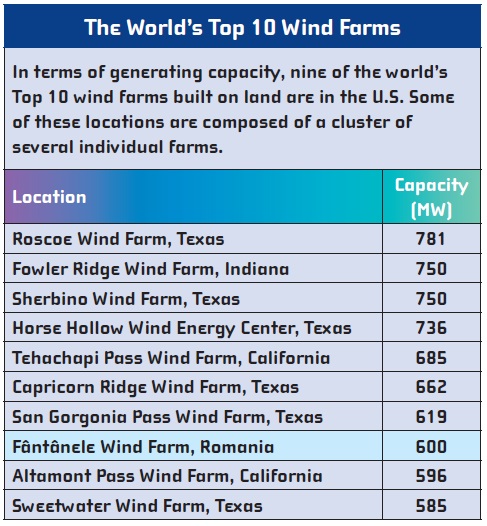
The similarities between the gearboxes used in wind turbines and the gearboxes used in aerospace applications allow some research crossover. Gearboxes in both industries operate under extremely demanding conditions, but one of the major differences is that during wind gusts, wind turbines are subjected to larger varying and cyclic stress loadings than jet engines or helicopter blades. Researchers are encouraged by the progress the aerospace industry has made in reducing or eliminating the same gearbox problems that persist in wind turbines.
DIRECT-DRIVE GENERATORS
Technology exists to eliminate gearboxes by replacing them with variable speed generators and solid-state electronic converters that produce utility-quality AC power. The trend began in smaller turbines and is now being incorporated in turbines sizes up to 3 mw. The downside is that direct-drive generators, which operate at lower rotational speeds, can cost up to 30% more than other turbines. They are generally larger in diameter and heavier than gear-driven turbines.
In direct-drive generators, the rotor is the only moving part. Butterfield’s company, Boulder Wind Power, is working on a lower-cost, lighter-weight model. Its first product, a permanent magnet generator that can reach peak efficiency at the midrange of the power curve, will be unveiled in three to four years.
Permanent magnet generators are the currently favored direct-drive generator. While these generators are highly efficient, they are unable to control field strength and have stringent manufacturing and tolerance requirements.
Lucas explains, “While the generators for the direct-drive turbines are much larger than the generators used with gearboxes, by using permanent magnet generators the generators can be made smaller than ones not using permanent magnets.”
A German company designed and introduced a direct-drive wind turbine that uses an annular multiple pole generator, which significantly reduces the number of moving parts and lowers the amount of repair work and down time. Unlike most electrical generators, which have four or six magnetic pole pairs in their windings and must use a gearbox, this direct-drive generator has 50-100 pole pairs that eliminate the need for a gearbox (
6).
The company’s premier model features a 12-meter-diameter annular generator and a 127-meter blade diameter. A side benefit is that coupling the blades directly to the generator, instead of to the gearbox, eliminates the mechanical noise produced by conventional turbines.
While Musial does see direct-drive generators as a potential alternative, he doesn’t believe gearboxes should be abandoned just yet.
“Direct-drive generators are an alternative,” he says, “but you are placing your faith in another component, the generator. It’s a gamble that the reliability issues will be better. I think the industry should do both; we should be building direct-drive generators and gearboxes until they get enough operating experience on the direct-drive system to show that they are reliable and can last 20 years.”
Another option for solving the gearbox problem is the use of a continuously variable transmission (CVT), which has recently been mass-produced in passenger vehicles (it was introduced in the Honda Civic in 1995). In contrast to the standard gearbox with its discrete varying capabilities limited to a set number of specific gear ratios, CVTs are capable of varying continuously through an unlimited number of gearing ratios.
FUTURE RESEARCH
Engineers are working to develop bearings and system designs that are more power-dense in order to keep the size of the components down and increase efficiency. While most turbines in current use are in the 1.5-2 mw range, Lucas says that he is now seeing 5-mw turbines, and manufacturers are working on 10-mw turbines.
“Future progress will focus on size and scale,” Lucas says. “Manufacturers need to keep turbines below a certain size because of transportation issues—when they get too big, they won’t fit under bridges.”
Kotzalas sees other areas that need more scrutiny.
“We need research that will help us understand the whole system, how the components interplay,” he says. “Getting down to the tribology, there are some interactions at the surface that might be mechanical and might be chemical but appear to be happening at certain locations. These aren’t well understood, and we need to figure out what’s happening. For example, we are seeing a white etch underneath the surface of the steel that we need to explore. There are a lot of different theories.”
The wind turbine industry, while poised for continued growth, is hampered by gearbox issues. Hopefully, the Gearbox Reliability Collaborative will provide answers soon.
But even with the gearbox problems, considering the size and weight of wind turbines and the extraordinary demands on their operating systems, they are magnificent machines. They have the potential to free much of the world from its dependence on environmentally damaging nonrenewable energy resources and tap, on a whole-scale level, a clean, nearly unlimited source of energy.
As Lucas puts it: “The potential for wind turbines remains very big.”
USEFUL LINKS
To see a moving animation of a wind turbine and appreciate
the stress on the gearbox, visit
here.
To learn more about wind, visit
here.
For a real-time meter of wind turbine energy generated, CO2 emissions reduced and number of wind turbines erected in Europe, visit
here.
REFERENCES
1.
For an explanation of Betz’s Law and details of a computer simulation challenge to the law, visit
here.
2.
In the U.S., farmers receive annual payments of anywhere from $2,000-$5,000 per turbine.
3.
See full report
here.
4.
Improving Wind Turbine Reliability, by Walter Musial and Sandy Butterfield. Published by the National Renewable Energy Laboratory, May 2007. Available
here.
5.
However, engineers note lower failure rates for bearing types specified for certain gearbox designs such as tapered roller bearings over spherical roller bearings for large direct-drive systems; and integrated flex systems for planetary gearsets over conventional planetary designs.
6.
Wind Turbine Gearbox Technologies, by Adam Ragheb and Magdi Ragheb,
Proceedings of the 1st International Nuclear and Renewable Energy Conference, Amman, Jordan, March 21-24, 2010.
 Jean Van Rensselar heads her own communication/public relations firm, Smart PR Communications, in Naperville, Ill. You can reach her at jean@smartprcommunications.com
Jean Van Rensselar heads her own communication/public relations firm, Smart PR Communications, in Naperville, Ill. You can reach her at jean@smartprcommunications.com.